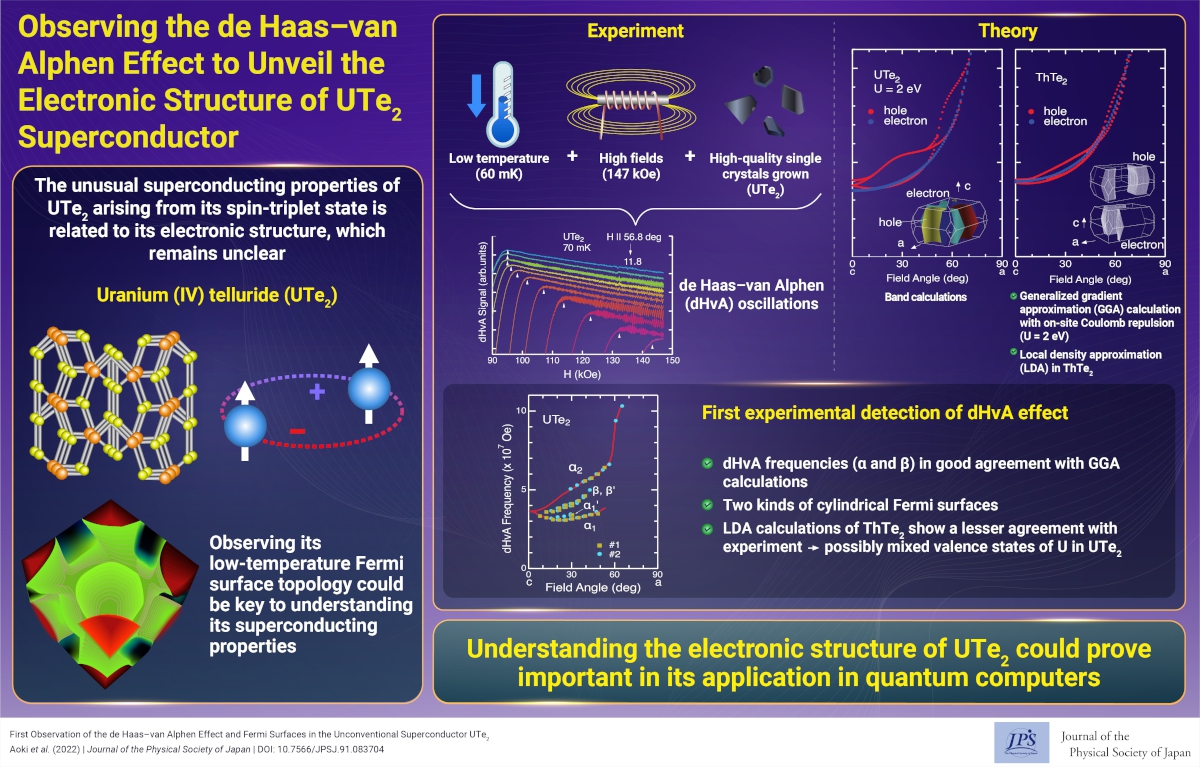Observing the de Haas–van Alphen Effect to Unveil the Electronic Structure of UTe2 Superconductor
© The Physical Society of Japan
This article is on
First Observation of the de Haas-van Alphen Effect and Fermi Surfaces in the Unconventional Superconductor UTe2
J. Phys. Soc. Jpn. 91, 083704 (2022).
The topology of Fermi surfaces with heavy effective masses in strongly correlated topological superconductor UTe2 was investigated using quantum oscillation measurements and theoretical calculations.

Heavy fermion UTe2 is one of the hottest topics in condensed matter physics. This is because of its unconventional superconducting properties, such as high field-reentrant superconductivity and multiple superconducting phases under pressure. Superconductivity is achieved owing to the formation of superconducting Cooper pairs of electrons. In UTe2, the unconventional pairing mechanism must be responsible for this; thus, the spin-triplet state is expected. It is crucial to investigate the electronic state microscopically, that is, to determine the Fermi surfaces using a microscopic experimental probe combined with a band theory.
A powerful experimental probe is the quantum oscillation measurement method, such as the de Haas–van Alphen (dHvA) effect, which is the oscillatory effect in magnetization caused by the quantization of cyclotron motions in high magnetic fields. Three conditions must be satisfied to detect quantum oscillations: low temperature, high magnetic field, and high-quality single crystals. These are somewhat difficult experimental conditions. In particular, high-quality single crystals are inevitably crucial for UTe2 with strong electronic correlations.
In this study, we grew the ultrapure single crystals of UTe2 using “a new recipe” of a single crystal growth technique, as demonstrated by a high and sharp superconducting transition in specific heat measurements. Using this high-quality single crystal, we successfully detected quantum oscillations (the dHvA effect) for the first time in UTe2. By rotating the field directions, the topology of Fermi surfaces is precisely determined experimentally. The results are consistent with the band structure calculations, indicating the existence of two types of cylindrical Fermi surfaces from the hole and electron bands. The dHvA signals are detected only at extremely low temperatures below 0.12 K, revealing the heavy effective mass resulting from strong electronic correlations.
The bare band structure calculations based on the 5f-itinerant model predict a small bandgap at the Fermi energy level, indicating a Kondo insulator. This is inconsistent with the real system because UTe2 is a good metal with a large carrier number. To explain the experimental results obtained from the band calculations, we need to introduce the onsite Coulomb interaction, U. This suggests a possible mixed valence state of UTe2.
As Fermi surfaces, known as the “face of metal,” are essential information for the electronic states, our results are a good starting point for clarifying unusual phenomena in UTe2 and other unconventional superconductors.
(Written by D. Aoki on behalf of all the authors.)
First Observation of the de Haas-van Alphen Effect and Fermi Surfaces in the Unconventional Superconductor UTe2
J. Phys. Soc. Jpn. 91, 083704 (2022).
Share this topic
Fields
Related Articles
-
A New Superconductor Family with Various Magnetic Elements
Superconductivity
Cross-disciplinary physics and related areas of science and technology
Electron states in condensed matter
2023-10-27
A new superconductor family, Sc6MTe2, has been discovered, comprising seven variations with magnetic elements labeled as M. Notably, only a few known superconductor families exist that involve various magnetic elements.
-
Dzyaloshinskii–Moriya Interactions in Magnetism, Electricity, and Electronics
Magnetic properties in condensed matter
Electron states in condensed matter
Dielectric, optical, and other properties in condensed matter
2023-10-12
A collection of papers in the Journal of the Physical Society of Japan advances our understanding of Dzyaloshinskii–Moriya interaction and paves the way for developing next generation computing and electronic systems.
-
Exploring Vortex Dynamics in a Multi-band Superconductor
Superconductivity
2023-8-22
We measured the microwave flux-flow Hall effect in FeSe, where the cancellation of holes and electrons was observed. This is a novel effect of multi-band superconductors.
-
Double Superconductivity in Nodal Line Material NaAlSi; Coexistence of Bulk and 2D Superconductivities
Superconductivity
Electronic structure and electrical properties of surfaces and nanostructures
2023-7-26
Unique diamagnetic torque signals are found in the nodal line material NaAlSi, which suggests the presence of double superconductivity; i.e., bulk superconductivity and 2D superconductivity on the crystal surface.
-
Self-Energy Singularity Explains High-Temperature Superconductivity in Cuprates
Superconductivity
Electron states in condensed matter
2023-7-18
A new review discusses the high-temperature superconductivity mechanisms in copper oxides, explaining the various phases observed in these materials based on a nonperturbative effect called self-energy singularity.
